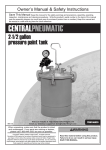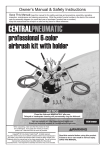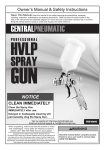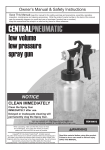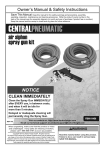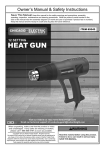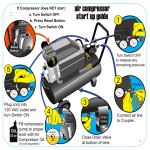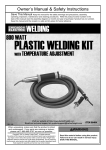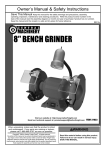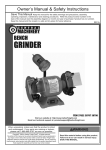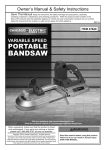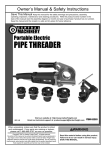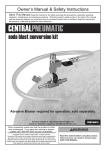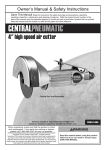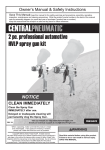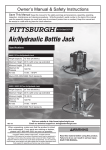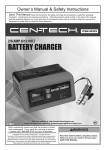Download Harbor Freight Tools 3/4 And 1_1/20 Oz Airbrush Kit Product manual
Transcript
Owner’s Manual & Safety Instructions Save This Manual Keep this manual for the safety warnings and precautions, assembly, operating, inspection, maintenance and cleaning procedures. Write the product’s serial number in the back of the manual near the assembly diagram (or month and year of purchase if product has no number). Keep this manual and the receipt in a safe and dry place for future reference. NOTICE Clean the Airbrush IMMEDIATELY after use. Delayed or inadequate cleaning will permanently clog the Airbrush. REV 14e Visit our website at: http://www.harborfreight.com Email our technical support at: [email protected] When unpacking, make sure that the product is intact and undamaged. If any parts are missing or broken, please call 1-888-866-5797 as soon as possible. Copyright© 2014 by Harbor Freight Tools®. All rights reserved. No portion of this manual or any artwork contained herein may be reproduced in any shape or form without the express written consent of Harbor Freight Tools. Diagrams within this manual may not be drawn proportionally. Due to continuing improvements, actual product may differ slightly from the product described herein. Tools required for assembly and service may not be included. Read this material before using this product. Failure to do so can result in serious injury. SAVE THIS MANUAL. NOTICE Clean the Airbrush IMMEDIATELY after use. Delayed or inadequate cleaning will permanently clog the Airbrush. Safety Table of Contents Safetye�������������������������������������������������2 Specifications......................................5 Setup...................................................6 Operationa�������������������������������������������10 Maintenancei��������������������������������������12 Parts List and Diagram.......................15 Warranty.............................................16 Setup WARNING SYMBOLS AND DEFINITIONS This is the safety alert symbol. It is used to alert you to potential personal injury hazards. Obey all safety messages that follow this symbol to avoid possible injury or death. Indicates a hazardous situation which, if not avoided, will result in death or serious injury. Indicates a hazardous situation which, if not avoided, could result in death or serious injury. Indicates a hazardous situation which, if not avoided, could result in minor or moderate injury. Operation Addresses practices not related to personal injury. IMPORTANT SAFETY INSTRUCTIONS INSTRUCTIONS PERTAINING TO A RISK OF FIRE, ELECTRIC SHOCK, OR INJURY TO PERSONS Maintenance The warnings and precautions discussed in this manual cannot cover all possible conditions and situations that may occur. It must be understood by the operator that common sense and caution are factors which cannot be built into this product, but must be supplied by the operator. WARNING – When using tools, basic precautions should always be followed, including the following: Work Area a. Keep the work area clean and well lighted. b. Keep bystanders, children, and Cluttered benches and dark areas visitors away while operating the tool. increase the risks of electric shock, Distractions are able to result in fire, and injury to persons. the loss of control of the tool. Page 2 For technical questions, please call 1-888-866-5797. Item 62294 NOTICE Personal Safety b. Dress properly. Do not wear loose clothing or jewelry. Contain long hair. Keep hair, clothing, and gloves away from moving parts. Loose clothes, jewelry, or long hair increases the risk of injury to persons as a result of being caught in moving parts. c. Do not overreach. Keep proper footing and balance at all times. Proper footing and balance enables better control of the tool in unexpected situations. d. e. Use safety equipment. Wear heavy‑duty work gloves and a NIOSH‑approved respirator during use. Non‑skid safety shoes and a hard hat must be used for the applicable conditions. Always wear eye protection. Wear ANSI‑approved safety goggles. Setup a. Stay alert. Watch what you are doing and use common sense when operating the tool. Do not use the tool while tired or under the influence of drugs, alcohol, or medication. A moment of inattention while operating the tool increases the risk of injury to persons. Safety Clean the Airbrush IMMEDIATELY after use. Delayed or inadequate cleaning will permanently clog the Airbrush. a. Do not force the tool. Use the correct tool for the application. The correct tool will do the job better and safer at the rate for which the tool is designed. b. Disconnect the tool from the air source before making any adjustments, changing accessories, or storing the tool. Such preventive safety measures reduce the risk of starting the tool unintentionally. Turn off and detach the air supply, safely discharge any residual air pressure, and release the throttle and/or turn the switch to its off position before leaving the work area. d. Check for misalignment or binding of moving parts, breakage of parts, and any other condition that affects the tool’s operation. If damaged, have the tool serviced before using. Many accidents are caused by poorly maintained tools. There is a risk of bursting if the tool is damaged. e. Use only accessories that are identified by the manufacturer for the specific tool model. Use of an accessory not intended for use with the specific tool model, increases the risk of injury to persons. Operation Tool Use and Care c. Store the tool when it is idle out of reach of children and other untrained persons. A tool is dangerous in the hands of untrained users. a. Tool service must be performed only by qualified repair personnel. Maintenance Service c. Use only lubricants supplied with the tool or specified by the manufacturer. b. When servicing a tool, use only identical replacement parts. Use only authorized parts. Item 62294 For technical questions, please call 1-888-866-5797. Page 3 NOTICE Clean the Airbrush IMMEDIATELY after use. Delayed or inadequate cleaning will permanently clog the Airbrush. Safety Air Source a. Setup Never connect to an air source that is capable of exceeding 200 psi. Over pressurizing the tool may cause bursting, abnormal operation, breakage of the tool or serious injury to persons. Use only clean, dry, regulated compressed air at the rated pressure or within the rated pressure range as marked on the tool. Always verify prior to using the tool that the air source has been adjusted to the rated air pressure or within the rated air-pressure range. b. Never use oxygen, carbon dioxide, combustible gases or any bottled gas as an air source for the tool. Such gases are capable of explosion and serious injury to persons. SAVE THESE INSTRUCTIONS. Symbol Definitions Symbol Operation PSI Property or Statement Pounds per square inch of pressure CFM Cubic Feet per Minute flow SCFM Cubic Feet per Minute flow at standard conditions NPT National pipe thread, tapered NPS National pipe thread, straight Symbol Property or Statement WARNING marking concerning Risk of Eye Injury. Wear ANSI‑approved eye protection. WARNING marking concerning Risk of Respiratory Injury. Wear NIOSH‑approved respirator. WARNING marking concerning Risk of Explosion. WARNING marking concerning Risk of Fire. Maintenance Page 4 For technical questions, please call 1-888-866-5797. Item 62294 NOTICE Clean the Airbrush IMMEDIATELY after use. Delayed or inadequate cleaning will permanently clog the Airbrush. 4. Read all of the information concerning coating products and cleaning solvents. Do not use chlorinated solvents (e.g. 1‑1‑1 trichloroethylene and dichloromethane, also known as methylene chloride) to clean airbrushes. Many airbrushes contain aluminum, which reacts strongly to chlorinated solvents. Contact the solvent or coating manufacturer as needed regarding potential chemical reactions. 5. Industrial applications must follow OSHA requirements. 6. Spraying hazardous materials may result in serious injury or death. Do not spray pesticide, acid, corrosive material, fertilizer, or toxic chemicals. 7. Paints and solvents may be harmful or fatal if swallowed or inhaled. Avoid prolonged skin contact with solvents or paints as they will irritate skin. After any contact, immediately wash off exposed area with hot, soapy water. 9. Install an in-line shutoff valve to allow immediate control over the air supply in an emergency, even if a hose is ruptured. 10.Air hose fittings may get hot during use. Allow fittings to cool before disconnecting. 11.WARNING: Some dust created by power sanding, sawing, grinding, drilling, and other construction activities, contains chemicals known to the State of California to cause cancer and birth defects or other reproductive harm. Some examples of these chemicals are: • Lead from lead-based paints • Crystalline silica from bricks and cement or other masonry products • Arsenic and chromium from chemically treated lumber Your risk from these exposures varies, depending on how often you do this type of work. To reduce your exposure to these chemicals: work in a well ventilated area, and work with approved safety equipment, such as those dust masks that are specially designed to filter out microscopic particles. (California Health & Safety Code § 25249.5, et seq.) 12.WARNING: The brass components of this product contain lead, a chemical known to the State of California to cause cancer and birth defects or other reproductive harm. (California Health & Safety Code § 25249.5, et seq.) Specifications Air Pressure Air Inlet Nozzle Size Item 62294 30 PSI 1/8″ - 28 NPS 0.03″ (0.75mm) Cup Capacity Air Consumption 3/4 oz. (22cc) & 3 oz. (88cc) 0.4 CFM @ 30 PSI For technical questions, please call 1-888-866-5797. Setup 3. Do not spray near open flames, pilot lights, stoves, heaters, the air compressor, or any other heat source. Most solvents and coatings are highly flammable, particularly when sprayed. Maintain a distance of at least 25 feet from the air compressor. If possible, locate the air compressor in a separate room. Operation 2. Do not exceed maximum air pressure. 8. Attach all accessories properly to the tool before connecting the air supply. A loose accessory may detach or break during operation. Maintenance 1. Do not direct spray at people or animals. Safety Specific Safety Instructions Page 5 NOTICE Clean the Airbrush IMMEDIATELY after use. Delayed or inadequate cleaning will permanently clog the Airbrush. Safety Functions Trigger Air Cap Mixing Jar Air Inlet Setup Nozzle Air Hose Lid Paint Jar Operation Air Line Adapter Figure A Propellant Can Lid (optional) Maintenance Page 6 For technical questions, please call 1-888-866-5797. Item 62294 NOTICE Clean the Airbrush IMMEDIATELY after use. Delayed or inadequate cleaning will permanently clog the Airbrush. Safety Initial Set Up Read the ENTIRE IMPORTANT SAFETY INFORMATION section at the beginning of this manual including all text under subheadings therein before set up or use of this product. TO PREVENT SERIOUS INJURY FROM EXPLOSION: Use only clean, dry, regulated, compressed air to power this tool. Do not use oxygen, carbon dioxide, combustible gases, or any other bottled gas as a power source for this tool. Note: Do not use an automatic oiler system or add oil to airline. The oil will contaminate the material being propelled, ruining the final result. 2. Attach an air hose to the compressor’s air outlet using the Air Line Adapter, as needed. Connect the air hose to the air inlet of the tool. Other components, such as a coupler plug and quick coupler, will make operation more efficient, but are not required. Note: Air flow, and therefore tool performance, can be hindered by undersized air supply components. 4. Turn on the air compressor according to the manufacturer’s directions and allow it to build up pressure until it cycles off. 5. Adjust the air compressor’s output regulator so that the air output is enough to properly power the tool, but the output will not exceed the tool’s maximum air pressure at any time. Adjust the pressure gradually, while checking the air output gauge to set the right pressure range. 6. Inspect the air connections for leaks. Repair any leaks found. 7. If the tool will not be used at this time, turn off and detach the air supply and safely discharge any residual air pressure to prevent accidental operation. 8. Residual air pressure should not be present after the tool is disconnected from the air supply. However, it is a good safety measure to attempt to discharge the tool in a safe fashion after disconnecting to ensure that the tool is disconnected and unpowered. Note: If desired, a can of propellant can be used instead with the Propellant Can Lid. Item 62294 Operation 1. Incorporate a filter, regulator with pressure gauge, in-line shutoff valve, and quick coupler for best service, as shown on Figure B on page 8 and Figure C on page 9. An in-line shutoff ball valve is an important safety device because it controls the air supply even if the air hose is ruptured. The shutoff valve should be a ball valve because it can be closed quickly. 3. Close the in-line shutoff valve between the compressor and the tool. For technical questions, please call 1-888-866-5797. Page 7 Maintenance Note: This air tool may be shipped with protective plugs covering the air inlets. Remove these plugs before set up. Setup Air Supply Setup Operation Maintenance A Air Hose B Filter D Regulator E Coupler and Plug C Air Cleaner / Dryer* F Air Adjusting Valve* *Optional components. Description A C Function E Connects air to tool Prevents dirt and condensation from damaging tool or workpiece Adjusts air pressure to tool Provides quick connection and release Prevents water vapor from damaging workpiece For fine tuning airflow at tool B A Setup Page 8 D F Safety Figure B: Portable Air Supply Setup Clean the Airbrush IMMEDIATELY after use. Delayed or inadequate cleaning will permanently clog the Airbrush. NOTICE For technical questions, please call 1-888-866-5797. Item 62294 Item 62294 For technical questions, please call 1-888-866-5797. D E F G H C F E Function F Page 9 Maintenance I I J Operation Filter Description J H L Coupler and Plug J Regulator K Lubricator* I N K H L O Function M F Safety Prevents dirt and condensation contamination Adjusts air pressure to tool For air tool lubrication Provides quick connection and release Increases coupler life Prevents moisture contamination For fine tuning airflow at tool L Setup M Leader Hose* N Air Cleaner / Dryer* O Air Adjusting Valve* *Optional components. Non-lubricated Tools C C For noise and vibration reduction Secures air compressor in place Isolates sections of system Ball Valve for maintenance Isolation Hose For vibration reduction Main Air Line - 3/4″ min. Distributes air to branch lines Ball Valve To drain moisture from system Branch Air Line -1/2″ min. Brings air to point of use Air Hose Connects air to tool Description B A A Vibration Pads B Anchor Bolts B A C D G Lubricated Tools Slope Figure C: Stationary Air Supply Setup Clean the Airbrush IMMEDIATELY after use. Delayed or inadequate cleaning will permanently clog the Airbrush. NOTICE NOTICE Clean the Airbrush IMMEDIATELY after use. Delayed or inadequate cleaning will permanently clog the Airbrush. Safety Operating Instructions Read the ENTIRE IMPORTANT SAFETY INFORMATION section at the beginning of this manual including all text under subheadings therein before set up or use of this product. Inspect tool before use, looking for damaged, loose, and missing parts. If any problems are found, do not use tool until repaired. Workpiece and Work Area Set Up Setup 1. Designate a work area that is clean and well‑lit. The work area must not allow access by children or pets to prevent distraction and injury. 2. Route the air hose along a safe path to reach the work area without creating a tripping hazard or exposing the air hose to possible damage. The air hose must be long enough to reach the work area with enough extra length to allow free movement while working. 3. Before spraying, mask nearby objects not being sprayed and lay cloths (not included) on the floors. 4. Prepare the workpiece according to paint manufacturer’s directions. Airbrush Setup and Adjustment Operation TO PREVENT SERIOUS INJURY: Do not adjust or tamper with any control or component in a way not specifically explained within this manual. Improper adjustment can result in tool failure or other serious hazards. CAUTION! Keep hands away from Trigger while making adjustments. IMPORTANT: Only use paints designed for use with an Airbrush. 5. Gently push the fitting on the Lid into the Airbrush. Maintenance Note: Proper paint mixture is essential. Note: The Jar is held in place Follow the manufacturer’s directions. Most paints by friction. It is not threaded. will spray easily if they are thinned properly. 6. Start the air compressor and set 1. Thin the paint according to manufacturer’s the regulator to needed pressure. directions and mix thoroughly. Do not exceed maximum air pressure. 2. Carefully strain the paint through a paint strainer. Note: To avoid clogging, start with the lowest pressure, increasing pressure if needed. 3. Fill the Paint Jar to no more than 3/4 full. Thread the Lid onto the Jar. 7. Test the consistency by spraying on a piece of scrap material. 4. Thread the Air Hose onto the Airbrush’s Air Inlet. Note: Adjust the regulator to regulate spray consistency. Page 10 For technical questions, please call 1-888-866-5797. Item 62294 NOTICE IMPORTANT: Proper spraying technique is ESSENTIAL to achieve good results. 4. For very fine detail work, you may decrease the distance up to 1″ from the workpiece. 1. Press down on the Trigger to release air from the Air Cap. Slowly and gently draw back on the Trigger to release paint from the Nozzle. The air will atomize the paint and create a fine spray. Note: The size of your spray pattern will differ based on the distance between the work surface and the Airbrush. The closer the Airbrush is, the finer the pattern will be. 2. Continue to move the Trigger back slowly to achieve the consistency you need for your spray technique. Note: If the Nozzle becomes clogged: a.Increase the Air Pressure to force out the clog. b.If the above does not work, clean the Nozzle manually. 6. Clean Airbrush and Paint Jar thoroughly immediately after EVERY use, according to instructions on the following pages. Maintenance Operation 3. Keep the distance from the workpiece at about 3″ to 5″, depending on the flow adjustment and the paint. 5. To avoid paint build up, start moving the Airbrush before pressing the Trigger. When finished with the stroke, release the Trigger while still moving the Airbrush. Doing this will produce a smoother finish. Do not stop moving the Airbrush while spraying. If the Airbrush stops even briefly while spraying the paint can build up and run down the workpiece. Setup General Operation Safety Clean the Airbrush IMMEDIATELY after use. Delayed or inadequate cleaning will permanently clog the Airbrush. Item 62294 For technical questions, please call 1-888-866-5797. Page 11 NOTICE Clean the Airbrush IMMEDIATELY after use. Delayed or inadequate cleaning will permanently clog the Airbrush. Safety Maintenance Instructions Procedures not specifically explained in this manual must be performed only by a qualified technician. TO PREVENT SERIOUS INJURY: Detach the air supply and safely discharge any residual air pressure in the tool before performing any inspection, maintenance, or cleaning procedures. Setup TO PREVENT SERIOUS INJURY FROM TOOL FAILURE: Do not use damaged equipment. If abnormal noise, vibration, or leaking air occurs, have the problem corrected before further use. Inspection Note: These procedures are in addition to the regular checks and maintenance explained as part of the regular operation of the air-operated tool. BEFORE EACH USE, inspect the general condition of the tool. Check for: •loose screws, •damaged air supply hose, •misalignment or binding of moving parts, •cracked or broken parts, and •clogged nozzle, •any other condition that may affect its safe operation. Operation Maintenance Page 12 For technical questions, please call 1-888-866-5797. Item 62294 NOTICE Clean the Airbrush IMMEDIATELY after use. Delayed or inadequate cleaning will permanently clog the Airbrush. Safety Cleaning TO PREVENT INJURY: Needles are very sharp. Use extreme caution when handling needles. Solvent Selection 3. Disconnect from the air source. Follow the paint manufacturer’s recommendations for cleaning, solvent type, and disposing of used solvent. 4. After disconnecting, point the Airbrush into the spent solvent container and depress the Trigger again to make sure no air remains. b.Flush Airbrush a full hose length from air compressor. c.If collecting flushed solvents in metal container, transfer to nonmetal container, and flush metal container. d.Work far away from any ignition sources in a vapor free area. e.Keep class ABC fire extinguisher nearby. Setup a.Follow solvent manufacturer’s clean up instructions and safety precautions. 5. Remove the Air Cap and Nozzle and soak them in solvent until clean. Use old toothbrush and toothpicks to remove any paint. CAUTION: Do not immerse Airbrush. Note: Do not use metal objects to clean the Nozzle to prevent damage to the passages. 6. Inspect Needle. If it is bent, have it replaced by a qualified technician. 7. Use appropriate solvent to wipe down Airbrush body. 8. Lubricate Airbrush after cleaning. A non‑silicon oil or a light lubricant may be used on threaded connections before storing. After each use: Solution Disposal 1. Empty the Jar and clean it with the solvent. After cleaning, dispose of cleaning solution according to the solution manufacturer’s directions and local hazardous waste standards. 2. Fill the Jar with solvent and spray it through the Airbrush into a container. Once the Jar is empty, repeat the process until the solvent comes out clean. Operation WARNING! TO PREVENT FIRE, IF A FLAMMABLE SOLVENT NEEDS TO BE USED, ADHERE TO THE FOLLOWING: Air Supply Maintenance Maintenance Every day, perform maintenance on the air supply according to the component manufacturers’ instructions. Storage Store in a dry, secure area out of reach of children. Item 62294 For technical questions, please call 1-888-866-5797. Page 13 NOTICE Clean the Airbrush IMMEDIATELY after use. Delayed or inadequate cleaning will permanently clog the Airbrush. Safety General Troubleshooting Chart Problem Poor Paint Atomization Possible Causes Likely Solutions 1.Low paint level. 1.Refill. 2.Paint not properly thinned. 2.Thin paint. 3.Clogged Nozzle. 3.Clean Nozzle. 4.Loose/damaged Needle. 4.Adjust or replace Needle. 1.No pressure at Airbrush. 1.Check air hoses. 2.Air Pressure Valve not open enough. 2.Open Air Pressure Valve. Overspray (Paint drifting to unintended objects.) 1.Improper application speed. 1.Move moderately and parallel. 2.Improper distance from workpiece. 2.Adjust distance. 3.Too much air pressure. 3.Reduce air pressure. Nozzle Leakage 1.Dirty Nozzle. 1.Clean Nozzle. 2.Worn or damaged Nozzle. 2.Replace Nozzle and/or Needle. 1.Dirty air valve/seat. 1.Clean air valve/seat. 2.Sticking air valve. 2.Lubricate air valve/seat. 3.Damaged air valve spring. 3.Replace air valve spring. 4.Worn/damaged air valve/seat. 4.Replace air valve. Will Not Spray Setup Air Leaking from Nozzle Operation Follow all safety precautions whenever diagnosing or servicing the tool. Disconnect air supply before service. PLEASE READ THE FOLLOWING CAREFULLY Maintenance THE MANUFACTURER AND/OR DISTRIBUTOR HAS PROVIDED THE PARTS LIST AND ASSEMBLY DIAGRAM IN THIS MANUAL AS A REFERENCE TOOL ONLY. NEITHER THE MANUFACTURER OR DISTRIBUTOR MAKES ANY REPRESENTATION OR WARRANTY OF ANY KIND TO THE BUYER THAT HE OR SHE IS QUALIFIED TO MAKE ANY REPAIRS TO THE PRODUCT, OR THAT HE OR SHE IS QUALIFIED TO REPLACE ANY PARTS OF THE PRODUCT. IN FACT, THE MANUFACTURER AND/OR DISTRIBUTOR EXPRESSLY STATES THAT ALL REPAIRS AND PARTS REPLACEMENTS SHOULD BE UNDERTAKEN BY CERTIFIED AND LICENSED TECHNICIANS, AND NOT BY THE BUYER. THE BUYER ASSUMES ALL RISK AND LIABILITY ARISING OUT OF HIS OR HER REPAIRS TO THE ORIGINAL PRODUCT OR REPLACEMENT PARTS THERETO, OR ARISING OUT OF HIS OR HER INSTALLATION OF REPLACEMENT PARTS THERETO. Page 14 For technical questions, please call 1-888-866-5797. Item 62294 NOTICE Parts List and Diagram 1 2 3 4 5 6 7 8 9 10 11 1 Description Qty Air Tip O-Ring Air Tip Bushing Body Handle Nozzle Fluid Needle O-Ring Clip Gasket Siphon Tube 2 3 1 1 1 1 1 1 1 1 1 1 1 Part 12 13 14 15 16 17 18 19 20 21 Description Qty Lid Paint Jar Mixing Jar Lid Mixing Jar Air Hose Air Line Adapter (1/4″ NPT x M5 x 0.5) O-Ring Adjusting Screw Propellant Can Lid O-Ring 1 1 1 1 1 1 1 1 1 1 Setup Part Safety Clean the Airbrush IMMEDIATELY after use. Delayed or inadequate cleaning will permanently clog the Airbrush. 5 4 18 6 16 19 Operation 7 8 9 20 14 12 10 15 Maintenance 11 21 13 17 Record Product’s Serial Number Here: Note: If product has no serial number, record month and year of purchase instead. Item 62294 Note: Some parts are listed and shown for illustration purposes only, and are not available individually as replacement parts. For technical questions, please call 1-888-866-5797. Page 15 Limited 90 Day Warranty Harbor Freight Tools Co. makes every effort to assure that its products meet high quality and durability standards, and warrants to the original purchaser that this product is free from defects in materials and workmanship for the period of 90 days from the date of purchase. This warranty does not apply to damage due directly or indirectly, to misuse, abuse, negligence or accidents, repairs or alterations outside our facilities, criminal activity, improper installation, normal wear and tear, or to lack of maintenance. We shall in no event be liable for death, injuries to persons or property, or for incidental, contingent, special or consequential damages arising from the use of our product. Some states do not allow the exclusion or limitation of incidental or consequential damages, so the above limitation of exclusion may not apply to you. THIS WARRANTY IS EXPRESSLY IN LIEU OF ALL OTHER WARRANTIES, EXPRESS OR IMPLIED, INCLUDING THE WARRANTIES OF MERCHANTABILITY AND FITNESS. To take advantage of this warranty, the product or part must be returned to us with transportation charges prepaid. Proof of purchase date and an explanation of the complaint must accompany the merchandise. If our inspection verifies the defect, we will either repair or replace the product at our election or we may elect to refund the purchase price if we cannot readily and quickly provide you with a replacement. We will return repaired products at our expense, but if we determine there is no defect, or that the defect resulted from causes not within the scope of our warranty, then you must bear the cost of returning the product. This warranty gives you specific legal rights and you may also have other rights which vary from state to state. 3491 Mission Oaks Blvd. • PO Box 6009 • Camarillo, CA 93011 • 1-888-866-5797
















